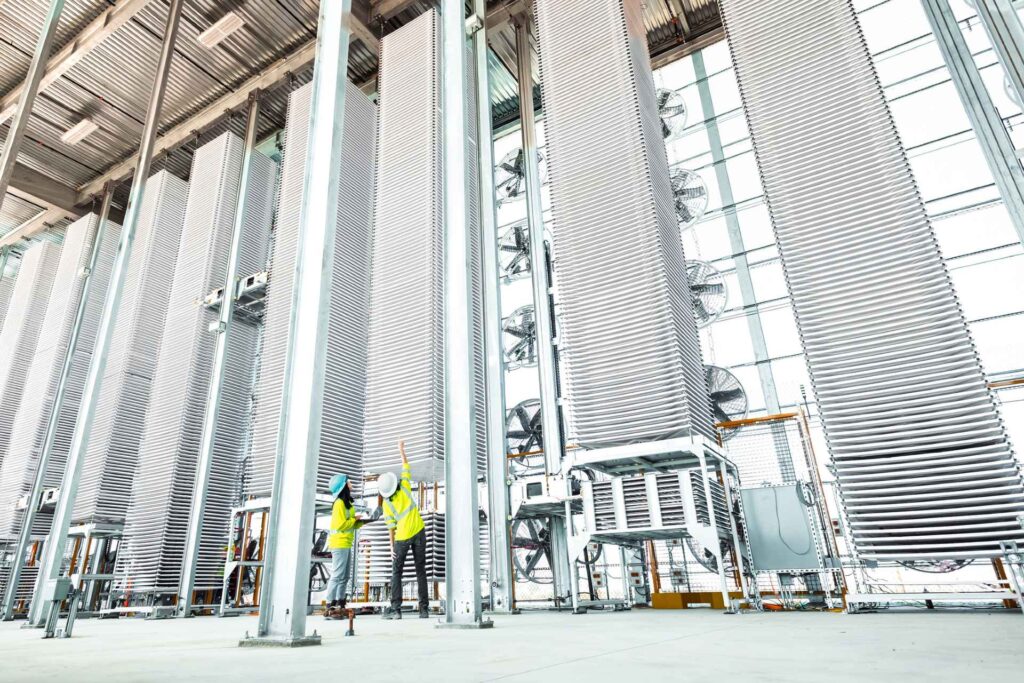The United States will be opening its first commercial facility for direct air capture (DAC) next year. The California plant looks set to be the first of many; the Department of Energy has set aside $3.5 billion in funding for DAC and the plan is to have four plants up and running in the next 10 years. Money has already been allocated for the next two, to be sited in Texas and Louisiana. Will this new technology prove to be a powerful weapon in the battle against climate change? And is the United Kingdom likely to follow suit?
A new technology
The concept of direct air capture was first suggested in 1999 and the first working DAC plant was built in 2021. So, this is still a very new technology.
The California plant, built by startup Heirloom Carbon Technologies, will use vacuum-like machines to suck CO2 out of the air. The rest of the process involves limestone, which already holds CO2 as part of its natural structure. The company grinds the limestone into powder and heats the powder in a kiln (powered by renewable energy) to remove the existing CO2. It then either stores the removed CO2 deep underground in concrete or mixes it into concrete. The mineral powder is then ready to bind with new sources of CO2 and will absorb it from the air that the machines have sucked in.
This is just one of various ways that DAC can potentially work. The methods fall into two broad categories: solid and liquid DAC. But last time we wrote about DAC, no form of the technology had yet been proven to work on a large scale.
The US government’s long-term plan for the country’s DAC plants is that each will eventually remove and store over a million imperial tons (slightly less than metric tonnes) of CO2 each year. But the soon-to-open California plant will only be capable of handling up to a thousand tons. So serious scaling up will be needed for DAC to achieve the levels of carbon removal that are planned for it.
The cost-effectiveness of carbon removal
Heirloom intend for their technology to cost less than USD $100 per imperial ton of CO2 removed by 2035. Data from the International Energy Agency suggests that this is possible. But it depends on many factors, including the capture technology and energy costs.
Right now the IEA’s estimate for the costs of carbon removal through direct air capture is a range between $125 and $335 per metric tonne. In contrast, at the time of writing (November 2023) the price of a tonne of carbon under the EU ETS was €83/tonne (around $90). On the UK ETS it was £41.52 (around $51). For direct air capture to be economically viable, the cost of the technology has to come down and/or the traded price of carbon has to increase – but both these scenarios look fairly likely.
Direct air capture in the UK
In the UK, some form of carbon removal is essential to our plan for achieving net zero emissions. 2021’s Net Zero Strategy sets out the ambition of removing 20-30 million tonnes of CO2 every year. But direct air capture is just one of the technologies being developed. The government is funding a mix of pilot projects in carbon capture, including biochar (turning biomass into a charcoal-like substance) and removing CO2 from seawater.
The variety of carbon capture technologies being piloted suggests that the UK government will be gathering much more information before it makes a decision on what to back on a large scale. But its fundamental approach is being called into question. Lawyers for Client Earth, Friends of the Earth and the Good Law Project took the government to the High Court in 2022 for having policies incompatible with our legally binding net zero target. They won, and in March 2023 the government produced a revised strategy.
But in October 2023 the group announced they were taking the government back to court. Why? The CEO of Client Earth, Laura Clarke, said: “The new plan still hinges on unreliable technologies to tackle climate change, which simply isn’t a stable solution.” The group want the UK government to focus on proven ways to reduce absolute emissions, such as better insulation, low-carbon heating and a faster move away from fossil fuels.
Whatever carbon removal technology the UK government chooses to develop at scale – whether DAC or something else – it will be risky in many ways to rely too heavily on it.
Featured image courtesy of Heirloom.

